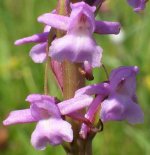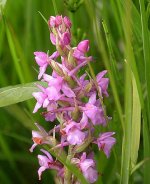So that's Waitby Greenrigs then!
I am not aware of any borealis there, despite the publicity material that is put out. I and a number of others I know have looked recently but not managed to find them.
I have a file somewhere with the differences summarized, and will dig that out when I'm on my other PC (on work laptop at moment).
In short though,
densiflora: usually deeper pink flowers, densely packed. lip wider than long and with shoulders. Lateral sepals held horizontally and long and blunt. Often plants are tall.
conopsea: variable colour, but generally pale pink, can be white. Lip strongly three-lobed and same width as height, lateral sepals held below horizontal, looks like it is shrugging and bored.
borealis: same colour as conopsea, but to me averages paler, lip longer than wide with less of a three-lobed appearance. Seems small in relation to the rest of the flower. More a "tall triangle" shape. Lateral sepals large cf lip and blade-shaped (quite wide vertically if you get what I mean), held below horizontal. Also - acid soil = borealis! However, it does grow on neutral and alkaline soils as well.
Hope this helps.
Cheers
Sean


















